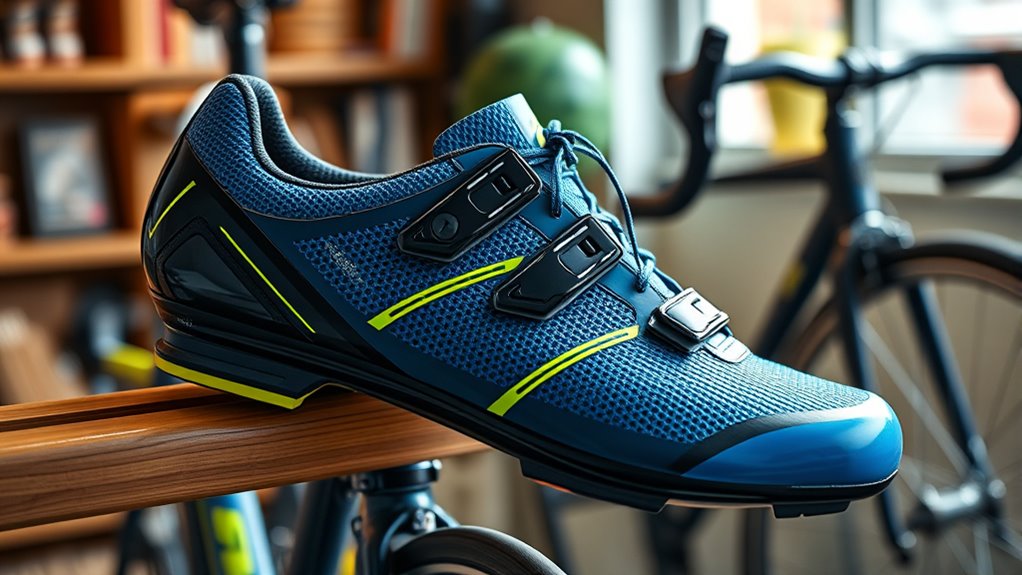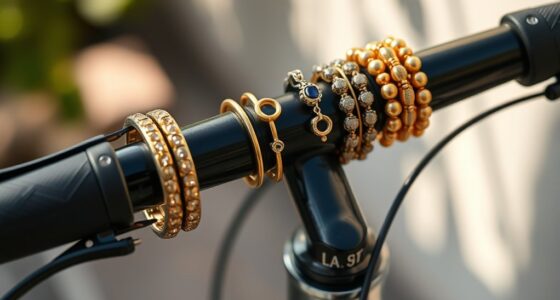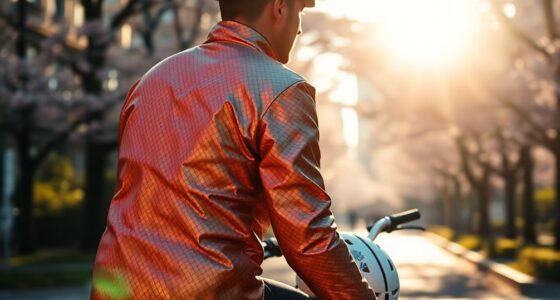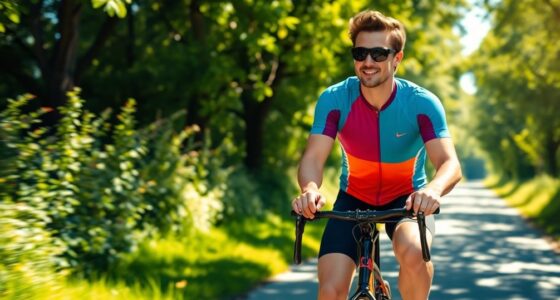Choosing the right cycling shoes can greatly boost your comfort and efficiency on commutes and rides. Look for footwear that fits snugly without pinching, and consider the type of riding you’ll do—casual shoes for easy speed, or stiff-soled options for more power. Pay attention to cleat compatibility to ensure smooth pedal engagement. With the right fit and features, your rides will feel smoother and more enjoyable; explore further to find the perfect pair for your cycling style.
Key Takeaways
- Choose shoes that match your riding style, whether for commuting or performance riding.
- Prioritize a snug, comfortable fit to prevent discomfort and blisters during rides.
- Ensure compatibility with your pedal system, such as SPD or road cleats, for optimal control.
- Consider shoe stiffness and weight for efficiency and comfort over your typical distances.
- Balance budget and quality to find durable, comfortable footwear suited to your cycling needs.

Cycling shoes are a essential gear that can considerably enhance your riding experience by improving efficiency, comfort, and power transfer. When you wear the right pair, you’ll notice how smoothly your pedaling becomes, allowing you to go farther and faster with less fatigue. Unlike regular sneakers, cycling shoes are designed specifically for riding, offering a stiff sole that maximizes the force you put into each pedal stroke. This stiffness means less energy is wasted and more is transferred directly to the bike. Whether you’re commuting through city streets or tackling a long weekend ride, choosing suitable cycling shoes can make a significant difference.
Cycling shoes boost efficiency, comfort, and power transfer for a better ride.
One of the first things to contemplate is the type of riding you plan to do most. If you’re mostly commuting or riding casually, look for shoes that prioritize comfort and ease of use. Many commuter shoes feature a more casual appearance, resembling regular sneakers but with the added benefit of compatibility with clipless pedals. These shoes often have recessed cleats, making walking easier when you’re off the bike. On the other hand, if you’re into competitive cycling or long-distance rides, performance-oriented shoes with a stiff sole and lightweight materials will serve you better. They provide maximum power transfer and often come with adjustable straps or BOA dials for a snug fit.
Fit is essential when choosing cycling shoes. They should feel snug without pinching or causing pressure points. Ill-fitting shoes can lead to discomfort, blisters, or numbness, ruining your ride. Try on shoes at the end of the day when your feet are slightly swollen, and always wear the socks you plan to ride in. Pay attention to the width as well, since some brands run narrow or wide. Proper fit ensures your foot stays securely in place, which improves pedaling efficiency and reduces the risk of injuries.
Another important aspect is the cleat system. Most cycling shoes are designed to be compatible with clipless pedals, which lock your foot into the pedal for better control and power. There are different systems, like SPD for mountain biking or road-specific cleats, so choose one based on your riding style. Installing cleats correctly on your shoes also matters; they should be positioned so your knee remains aligned over the pedal spindle, preventing joint strain.
Finally, consider your budget and the features you need. You don’t have to spend a fortune to find a decent pair, but investing in quality footwear pays off through better comfort and durability. Remember, the right cycling shoes are an investment that can elevate every ride, making your cycling experience more enjoyable and efficient.
Frequently Asked Questions
Can Cycling Shoes Be Used for Running?
You might wonder if cycling shoes work for running. While they’re designed to optimize pedaling efficiency, they’re not the best choice for running. Cycling shoes typically have stiff soles that can make running uncomfortable and less natural. If you need to switch between cycling and running, consider using versatile shoes or specific running footwear to avoid discomfort and potential injuries. Stick to appropriate shoes for each activity for the best experience.
How Do I Choose the Right Size?
Sizing shoes simply seems straightforward, but it’s really about precision and comfort. You should measure your feet size accurately, preferably in the afternoon when feet are at their largest. Try on shoes with the socks you’ll wear biking, and guarantee there’s a snug fit without pinching. Remember, different brands can vary, so always check size charts and, if possible, test them out before buying.
Are Expensive Shoes Worth the Investment?
When deciding if expensive cycling shoes are worth it, consider your riding habits and comfort needs. Higher-priced shoes often offer better materials, improved fit, and enhanced performance, which can make your rides more enjoyable and efficient. If you ride frequently or compete, investing in quality footwear pays off. However, if you’re a casual rider, a more affordable option might suit you just fine without sacrificing comfort or safety.
What Are the Benefits of Clipless Pedals?
The benefits of clipless pedals are like revealing a secret power you never knew your bike had. They improve your pedaling efficiency, making every stroke feel smooth and controlled. You’ll experience better control, increased comfort, and more energy transfer, helping you ride longer and faster. Plus, they keep your feet securely in place, reducing fatigue and the risk of slips. Once you try them, you’ll wonder how you ever rode without them.
How Often Should I Replace My Cycling Shoes?
You should replace your cycling shoes when they show significant wear, lose their support, or no longer fit comfortably. Typically, expect to replace them every 6 to 12 months if you ride regularly. Check the soles for worn-out cleats or sole damage and look for cracks or frayed straps. Regularly inspecting your shoes helps prevent discomfort and injury, ensuring your rides stay efficient and enjoyable.
Conclusion
Choosing the right cycling shoes is like finding the perfect pair of running shoes—they can make or break your ride. I once swapped my old sneakers for specialized cycling shoes, and suddenly, my pedaling felt smoother, almost like gliding on ice. Remember, investing in good footwear enhances efficiency and comfort, turning every commute or ride into a more enjoyable experience. So, don’t settle—your best ride starts with the right pair on your feet.









